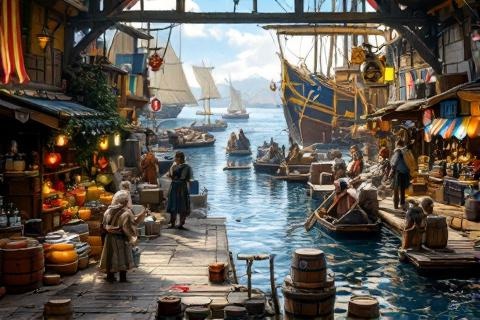
Esgaroth: The Lake-town of Legends
Secrets, Stories, and the Fall of the Floating City in Middle-earth
The Unique Architecture of Lake-town

Esgaroth, commonly known as Lake-town, stood as a remarkable feat of engineering
in Middle-earth, constructed entirely upon massive wooden
pillars driven deep into the bed of the Long Lake. These sturdy supports
elevated the entire settlement above the water's surface, creating a unique
floating city that had endured for generations of Men. The
foundations consisted of ancient hardwood pillars that had become black and
strong as stone through centuries of preservation in the cold waters.
The town's sole connection to the western shore was a long wooden bridge, wide
enough for wagons to pass and stretching several hundred feet across the water.
At its shore end stood impressive gates and guard towers, serving as both the
primary defense point and the control center for all traffic entering and
leaving the town. The gates were shut at night and during times of danger,
providing the town with its first line of defense against unwanted visitors.
The town itself was a marvel of wooden architecture, featuring multiple tiers of
buildings and interconnected walkways that created a complex urban environment
above the lake's surface. The different levels served various purposes, with the
higher platforms offering spaces for residential quarters and public buildings,
while the lower levels housed warehouses and workshops. This vertical
arrangement maximized the limited space available on the platform and created an
efficient use of the town's footprint.
Esgaroth's position on the water proved to be a brilliant defensive strategy
against land-based threats, particularly from the dangers that occasionally
emerged from the northern wastes. The water gap between the town and shore made
it nearly impossible for enemies without boats to launch a direct assault, while
the controlled access point of the bridge could be easily defended or destroyed
if necessary. This security allowed the town to flourish even in times when
other settlements in the region faced significant threats.
A Trading Hub of the North

Located strategically between the realms of the Woodland Elves to
the west, the Iron Hills Dwarves to the east, and the
various settlements of Men, Esgaroth served as the primary trading hub of the
northern regions of Middle-earth. The town's position made it the natural
meeting point for these diverse cultures, facilitating trade agreements and
cultural exchange that had lasted for centuries. Its markets were renowned for
offering goods from all corners of Rhovanion and beyond.
The harbor of Esgaroth was a constant hive of activity, with numerous trading
vessels ranging from small fishing boats to large merchant ships arriving and
departing daily. The lake provided a natural highway for commerce, and the
town's docks could accommodate dozens of vessels simultaneously. Skilled
mariners from Lake-town were known throughout the region for their ability to
navigate the Long Lake in all weather conditions.
Among the most famous trade goods passing through Esgaroth were the wine barrels
from the Woodland Realm. These barrels, after being emptied of their precious
cargo in King Thranduil's halls, were returned via the
Forest River to Lake-town, where they were collected and recycled. This trade
became so regular and significant that it created a well-established water route
that would later prove crucial in Bilbo's rescue of
the dwarves.
The economy of Esgaroth thrived on its merchant culture, with wealth flowing
into the town through various trade ventures and commercial enterprises. The
town's merchants were known for their shrewd business sense and far-reaching
trade networks. Their prosperity was evident in the well-maintained buildings,
the quality of goods available in the markets, and the general high standard of
living enjoyed by most of the town's inhabitants.
Daily Life in Lake-town
The people of Esgaroth were renowned throughout the region for their exceptional
skill in boat-building and fishing. Their craftsmen developed specialized
techniques for constructing vessels that could weather the often harsh
conditions of the Long Lake, from small fishing boats to larger trading vessels.
The boat-builders of Lake-town passed their knowledge down through generations,
maintaining a high standard of craftsmanship that made their vessels sought
after throughout the northern regions.
The architectural style of Lake-town was unique among the settlements of Men,
featuring tall wooden buildings with multiple stories and elaborate decorative
elements that reflected the prosperity of its inhabitants. The structures were
built using techniques perfected over centuries, with tight-fitting joints and
careful consideration of weight distribution. The buildings often featured
overhanging upper floors and carved details that demonstrated the skill of local
craftsmen.
Between the buildings ran a complex network of water-streets, creating channels
that served as thoroughfares for boats and smaller craft. These waterways were
carefully planned to allow efficient movement throughout the town while
maintaining the structural integrity of the platform city. The water-streets
formed a crucial part of daily life, with many businesses and homes having their
own small docks or water-gates for direct access.
The town's engineers developed sophisticated systems for managing water-related
challenges, including methods to detect and control fires, which posed a
particular threat to the wooden settlement. Fresh water was collected through an
ingenious system of rainfall capture and filtered lake water, while waste
management systems were designed to prevent contamination of the lake waters
around the town. These systems demonstrated the technical sophistication of
Lake-town's inhabitants and their ability to adapt to their unique environment.
Defensive Features

The central location of Esgaroth in the Long Lake provided multiple strategic
advantages for the town's defense and commerce. The distance from shore meant
that the town could not be reached by conventional land-based siege weapons,
while the open water allowed defenders to spot approaching threats from any
direction. The lake's considerable depth at this point also prevented any
attempt to attack the town from underneath.
The town's distance from the shore created a natural moat that proved invaluable
for defense against various threats, from roving bands of outlaws to more
dangerous creatures from the northern wastes. This separation from the mainland
meant that any attacking force would need considerable naval resources to pose a
serious threat, a rare capability in the northern regions of Middle-earth.
Strategic watchtowers were positioned at key points throughout Lake-town, manned
by guards who maintained constant vigilance over both the lake and the distant
shores. These towers were equipped with warning bells and signal fires to alert
the town of approaching dangers. The guards followed strict protocols for
monitoring traffic on the lake and maintaining communication between watch
posts.
The great bridge represented both the town's lifeline and its most defendable
point, with multiple security measures in place to control access. The bridge's
design included sections that could be quickly dismantled in case of emergency,
while the gatehouse was built to withstand significant attacks. Guard posts
along the bridge allowed for careful monitoring of all traffic, ensuring that no
unauthorized persons or goods entered the town.
Government and Society
The governance of Esgaroth was centered around the Master of Lake-town and a
town council, representing a unique political structure among the settlements of
Men in Middle-earth. The Master was elected by the townspeople, though the
position tended to favor those who had already accumulated wealth and influence.
The council helped balance the Master's authority and ensured that various
interests within the town were represented in decision-making.
The merchant class held significant influence in Lake-town's society, with
wealthy traders often serving on the town council and helping shape local
policies. Their prosperity directly impacted the town's overall wellbeing, as
their trade activities brought wealth that benefited the entire community. The
merchants maintained extensive networks of contacts throughout Middle-earth,
keeping Esgaroth well-informed of events in distant lands.
Lake-town's democratic traditions set it apart from many other settlements of
Men, with regular town meetings and elections being a crucial part of civic
life. The people of Esgaroth took pride in their system of governance, which
allowed for public participation in important decisions and maintained a degree
of accountability for their leaders. This democratic spirit was reflected in the
town's laws and customs.
The political relationships between Esgaroth and its neighbors were carefully
managed through a combination of trade agreements and diplomatic exchanges. The
town maintained particularly important ties with the Woodland Realm and the
dwarves of the Iron Hills, balancing these relationships to ensure continued
prosperity. The town's leaders were skilled in navigating the complex political
landscape of the region, maintaining Esgaroth's independence while fostering
beneficial alliances.
Environmental Adaptations

The buildings of Esgaroth were specifically designed to withstand the harsh
weather conditions of the northern climate, incorporating features that
protected against strong winds, heavy snowfall, and extreme cold. The structures
utilized steep-pitched roofs to prevent snow accumulation, while walls were
built with multiple layers of wooden planking to provide insulation. Special
attention was paid to sealing joints and openings to prevent drafts and water
penetration.
The unique environment of Lake-town required specialized construction techniques
that evolved over generations of building experience. Foundations were carefully
designed to distribute weight evenly across the platform, while buildings were
constructed with flexible joints that could accommodate the natural movement of
the lake. The wooden pillars supporting the town were regularly inspected and
maintained, with damaged sections being replaced using sophisticated engineering
methods.
The town's water management systems were a testament to the ingenuity of its
inhabitants, featuring innovative solutions for collecting and storing fresh
water while managing waste disposal. Rainwater was collected through an
elaborate system of gutters and storage tanks, while specialized filtration
systems made lake water potable. The waste management system utilized the lake's
natural currents to carry waste away from the town while preventing
contamination of drinking water sources.
Seasonal changes in the Long Lake's water levels required careful adaptation in
Lake-town's infrastructure. Buildings and walkways were designed with adjustable
elements that could accommodate rising and falling water levels, while the
town's support structures were built to remain stable regardless of water depth.
This adaptability ensured that daily life could continue uninterrupted
throughout the year, despite the challenging environmental conditions.
